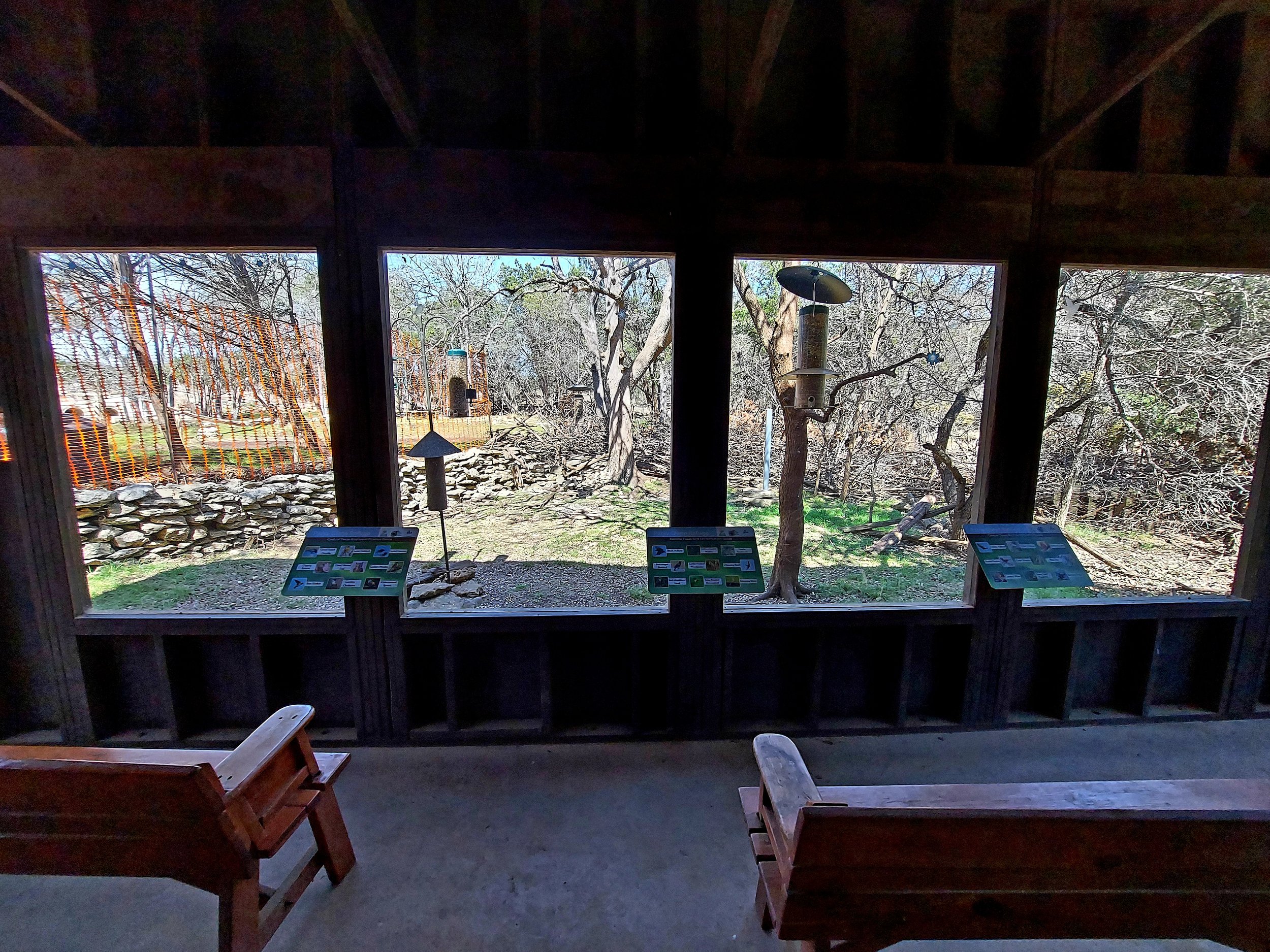Patsy Glenn Refuge
Photos by Melinda Seib
The Patsy Glenn Refuge encourages and protects birds and all wildlife. It has also served to inform and educate visitors, including area school children, and to improve the Cypress Creek watershed. Through Patsy Glenn’s efforts, an unused portion of land next to the proposed Wimberley Community Center was turned over to the Wimberley Birding Society for development as a bird sanctuary. In 2001, Patsy enlisted over 60 volunteers to clear the land, create nature trails, wildflower areas and feeders to attract birds. She later guided numerous improvements, including a chimney swift tower, a viewing station, a rainwater collection system and a butterfly garden.
Patsy Glenn Refuge provides food, water and shelter for birds and other wildlife in the center of town. Also, there are many native plants that feed the birds with their seeds and berries as well as attracting insects that birds eat. You will find birds in the trees, on the ground, and near the feeders or water sources.
Location
14068 Ranch Road 12, Wimberley, TX 78676
Turn East at the stoplight at Highway 12 and River Road in Wimberley. Drive in front of the historical Winters-Wimberley House and the Community Center to the Patsy Glenn Refuge beyond the end of the parking lot.
Hours of Operation: Daylight Hours
Additional Birding Resources
Here are some additional places to visit that have Chimney Swift towers:
TEKS CONNECTION
Science:
2nd Grade
2.7 Earth and space. The student knows that the natural world includes earth materials.
2.7(C) distinguish between natural and manmade resources
2.9 Organisms and environments. The student knows that living organisms have basic needs that must be met for them to survive within their environment.
2.9(C) compare the ways living organisms depend on each other and on their environments such as through food chains
2.9(A) identify the basic needs of plants and animals
2.9(B) identify factors in the environment, including temperature and precipitation, that affect growth and behavior such as migration, hibernation, and dormancy of living things
2.10 Organisms and environments. The student knows that organisms resemble their parents and have structures and processes that help them survive within their environments.
2.10(A) observe, record, and compare how the physical characteristics and behaviors of animals help them meet their basic needs
3rd Grade
3.9 Organisms and environments. The student knows and can describe patterns, cycles, systems, and relationships within the environments.
3.9(A) observe and describe the physical characteristics of environments and how they support populations and communities of plants and animals within an ecosystem
3.10 Organisms and environments. The student knows that organisms undergo similar life processes and have structures that help them survive within their environments.
3.10(A) explore how structures and functions of plants and animals allow them to survive in a particular environment
4th Grade
4.9 Organisms and environments. The student knows and understands that living organisms within an ecosystem interact with one another and with their environment.
4.9(A) investigate that most producers need sunlight, water, and carbon dioxide to make their own food, while consumers are dependent on other organisms for food
4.10 Organisms and environments. The student knows that organisms undergo similar life processes and have structures and behaviors that help them survive within their environments.
4.10(A) explore how structures and functions enable organisms to survive in their environment
4.10(B) explore and describe examples of traits that are inherited from parents to offspring such as eye color and shapes of leaves and behaviors that are learned such as reading a book and a wolf pack teaching their pups to hunt effectively
Social Studies:
2nd Grade
2.5 Geography. The student understands how humans use and modify the physical environment.
2.5(B) identify consequences of human modification of the physical environment
3rd Grade
3.3 Geography. The student understands how humans adapt to and/or modify the physical environment.
3.3(B) identify and compare how people in different communities adapt to or modify the physical environment in which they live such as deserts, mountains, wetlands, and plains
3.3(C) describe the effects of human processes such as building new homes, conservation, and pollution in shaping the landscape
4th Grade
4.8 Geography. The student understands how people adapt to and modify their environment.
4.8(B)^ explain reasons why people have adapted to and modified their environment in Texas, past and present, such as the use of natural resources to meet basic needs, facilitate transportation, and enhance recreational activities
English Language Arts & Reading:
2nd Grade
2.9 Genres: The student recognizes and analyzes genre‐specific characteristics, structures, and purposes within and across increasingly complex traditional, contemporary, classical, and diverse texts.
2.9(D) recognize characteristics and structures of informational text, including: (ii) features and graphics to locate and gain information
3rd Grade
3.9 Genres. The student recognizes and analyzes genre‐specific characteristics, structures, and purposes within and across increasingly complex traditional, contemporary, classical, and diverse texts.
3.9(D) recognize characteristics and structures of informational text, including: (ii) features such as sections, tables, graphs, timelines, bullets, numbers, and bold and italicized font to support understanding
4th Grade
4.9 Genres. The student recognizes and analyzes genre-specific characteristics, structures, and purposes within and across increasingly complex traditional, contemporary, classical, and diverse texts.
4.9(D) recognize characteristics and structures of informational text, including: (ii) features such as pronunciation guides and diagrams to support understanding
Source: Lead4Ward



